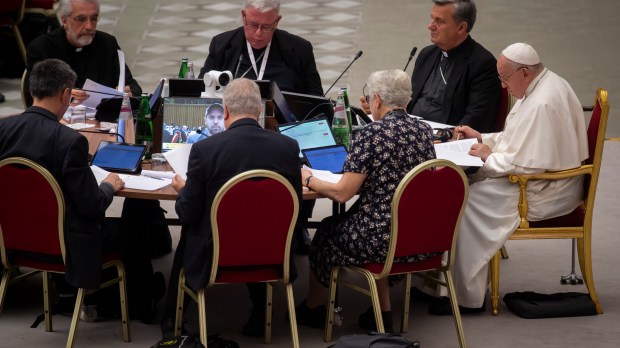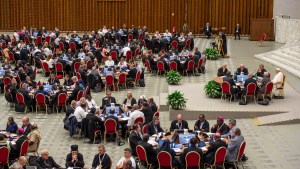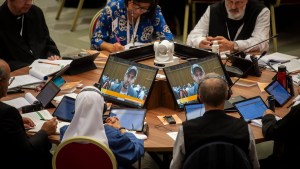Without waiting for the results of the conclusion of the Synod on Synodality — a major process of reflection opened in 2021 and due to hold its final session in October 2024 — Pope Francis has set up working groups on crucial topics, which have more than a year to submit their reports.
This was announced by the Synod’s organizers on March 14, 2024, at a press conference at the Holy See, where they presented developments in the work. The Pontiff is thus keeping a hand on the results of this Synod intended to reform the Church, and which was due to conclude at the end of the year.
Various entities — such as the world’s bishops’ conferences — are being consulted to prepare the working document for the forthcoming October session. However, the Synod secretariat has clarified that Synod members are not expected to address the issue of priestly celibacy, nor the controversial document on the blessing of same-sex couples, Fiducia suplicans.
On the other hand, they will address other sensitive issues such as a female diaconate and criteria for selecting bishops.
In the wake of these announcements, I.MEDIA takes stock of the Synod’s work in progress, its stages and its prospects.
Where does the Synod stand today?
The major synodal project was launched in October 2021, with a consultation process that began at local level, in parishes and dioceses. All parts of the Catholic Church — clergy, religious, and laity — took part in the conversation, with the aim of making the Church more participative, more decentralized, and less clerical. The following year, work continued in the same way at the continental level.
Then, in October 2023, the first phase of the world assembly took place in Rome. For a month, 464 cardinals, bishops, priests, and lay men and women — who for the first time in history had the right to vote — gathered around the Pope. This high-profile assembly concluded with a synthesis, which will serve as a guideline until the second assembly, scheduled for October 2 to 27, 2024. Participants are expected to be the same as for the October 2023 session.
What is going on until October?
Various entities are involved in preparations for the second session of the world assembly.
From April 28 to May 2, 300 priests from all the world’s Churches will meet in Rome to exchange ideas. A list of participants is due to be drawn up shortly.
In addition, the world’s dioceses, which have been invited to study the synthesis document, are invited to send their contributions to Rome by May 15.
Lastly, five groups of experts set up by the Synod secretariat will carry out a theological study on five areas, covering themes as diverse as ministries (including the female diaconate), the bishops’ responsibility in the fight against abuse, and the question of authority in the Church.
The results of all these reflections will be used to draw up the Instrumentum laboris, the working document for the October assembly.
In parallel, Pope Francis has decreed the formation of 10 groups for “in-depth study” of major questions raised during the synodal process, with “theological and pastoral” repercussions, as he explained in a letter published on March 14 (See the 10 themes at the bottom of the article).
These groups are to be set up with the contribution of the Vatican dicasteries competent for each theme, a sign of the Roman Curia’s greater involvement. These groups will submit their conclusions to the Pope at the end of June 2025.
What will the Synod discuss in October?
Since its opening, the Synod has been the subject of much debate as it tackles burning issues for the future of the Church (the role of women, welcoming irregular couples, governance, the fight against abuse, etc.). Fr. Piero Coda, General Secretary of the International Theological Commission, confirmed that the agenda next October will include women’s access to the diaconate and the criteria for choosing candidates for the episcopate.
However, Cardinal Mario Grech, General Secretary of the Synod, has said that the issue of priestly celibacy has never been on the table. Cardinal Jean-Claude Hollerich, General Reporter of the Synod, said that the document Fiducia supplicans from the Dicastery for the Doctrine of the Faith, which allows pastoral blessings — but not ritual blessings — for people who form a same-sex couple, should not be taken up by the assembly either.
In addition, a presentation of the avenues studied by the 10 working groups mandated by the Pope will be made to the participants. These ideas will be added to the reflections contained in the working document to be released before the session.
Will the Synod ever come to an end?
The Synod on Synodality is due to conclude on October 27, but many issues will remain open long after that date. The fact that the conclusions of the 10 working groups will be submitted to the Pope at the end of June 2025 suggests that the process initiated by Francis will continue. The Argentine Pontiff himself has repeatedly explained his desire to instill a “synodal way of being” in the Church.
The 10 themes selected by the Pope, explained Fr. Coda, are not the main focus of the Synod, but are to be tackled as “long-term issues.” In launching these groups, added Cardinal Grech, the Pope has not waited for the conclusions of the second session, but he has “taken note” of the “important” themes emerging in the debates, and he “is looking forward to the results.”
“The synodal process is not designed to create big news; here, we’re moving forward slowly and serenely,” Cardinal Hollerich added, once again denying the perspective of “ecclesiastical politics.”
The 10 working groups
Themes to be studied by the 10 working groups established by the Pope, as reported by Vatican News:
1. Some aspects of the relationship between the Eastern Catholic Churches and the Latin Church (SR 6)
2. Listening to the Cry of the Poor (SR 4 and 16)
3. The mission in the digital environment (SR 17)
4. The revision of the Ratio Fundamentalis Institutionis Sacerdotalis in a missionary synodal perspective (SR 11)
5. Some theological and canonical matters regarding specific ministerial forms (SR 8 and 9)
6. The revision, in a synodal missionary perspective, of the documents touching on the relationship between Bishops, consecrated life, and ecclesial associations (SR 10)
7. Some aspects of the person and ministry of the Bishop (criteria for selecting candidates to Episcopacy, judicial function of the Bishops, nature and course of ad limina Apostolorum visits) from a missionary synodal perspective (SR 12 and 13)
8. The role of Papal Representatives in a missionary synodal perspective (SR 13)
9. Theological criteria and synodal methodologies for shared discernment of controversial doctrinal, pastoral, and ethical issues (SR 15)
10. The reception of the fruits of the ecumenical journey in ecclesial practices (SR 7)



